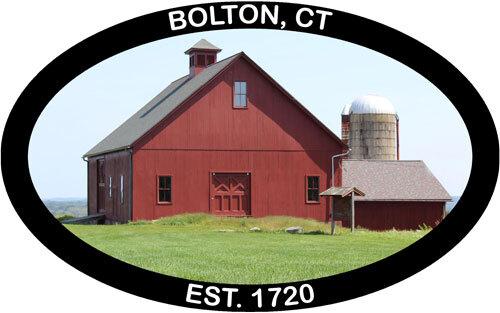Bolton is one of the older Connecticut towns, having been incorporated in October 1720. Many of the early settlers came from Bolton, Lancashire, England, from which the town received its name. It covers an area along the extreme western edge of the rolling eastern Connecticut upland, overlooking the Connecticut River Valley to the west. Bolton is mountainous, with level ground primarily in the Bolton Center and Notch Pond areas. Bolton is located about 15 miles east of Hartford. The area of the town is 15.5 square miles, and it is bounded by the towns of Manchester and Glastonbury on the west, Coventry on the east, Andover and Hebron on the south, and Vernon on the north.
Bolton was originally part of the hunting ground of the Podunk Indians. The Podunks lived in what is now East Hartford and South Windsor, along the Podunk River. In the early 1600s when the first settlers moved east from Hartford to the Bolton area, they traveled on the Olde Connecticut Path. It started in East Hartford and led through Manchester and Bolton Notch to Willimantic. It was joined by the Pequot and Mohegan trail from the south at Willimantic, and by the Nipmunk trail from the northwest. Most early historians agree that Bolton Notch was the boundary between the Podunk territory to the west and the Mohegan territory to the east. The Indians called it Saqumsketuck, which means land or place at the hard rock.
Bolton had been part of the Town of Hartford until 1720, and known as Hartford Mountains or Hanover. On October 9, 1720, the following men submitted a petition to the general court asking for town privileges: Cullott Olcott, John Bissell, Stephen Bishop, Abiel Shaylor, Timothy Olcott, Joseph Pomeroy, Nathanial Allis, Edward Rose, John Clark, Charles Loomis, Samuel Bump, Daniel Dartt, John Church, Thomas Marshall, and Samuel Raymond. Jabez Loomis of Windsor, Connecticut recorded the first deed in 1718, found on page one of volume one of the Bolton Land Records.
In 1721, at a town meeting, it was voted to construct a Meeting House, and on May 27, 1723, the call was given to the 20-year-old Reverend Jonathan Edwards to be the first minister. At first Reverend Edwards accepted the call, but soon afterwards was appointed a tutor at Yale College. So the man who was later to become one of the most celebrated writers and speakers in colonial America did not become the pastor of Bolton. In 1725, the Reverend Thomas White became Bolton’s first minister.
Methodist meetings were first held in 1823 at the home of Isaac Keeney in the Quarryville section of town.
Schools were first established in Bolton in 1732, when it was voted at a town meeting to keep school at three locations in town. However, that decision was rescinded in 1733, and the first permanent schools were not established in Bolton until 1749. The Town had just been divided into four quarters, and a school was established in each. Residents were permitted to send their children to any school in town. By 1823 there were five school districts: Center, North, South, Southwest, and Talcott Northwest.
By 1774 the residents of Bolton were still affirming their loyalty to the King of England, but at the same time voting at a town meeting to cooperate with their brethren in the other colonies to defend the liberties of British America. They also voted to offer relief to those in Boston who were suffering from the measures taken by the British Parliament, and to form a Committee of Correspondence with Thomas Pitkin, Esq., Ichabod Warner, Isaac Fellows, Samuel Carver, Jr., and Benjamin Talcott, Jr. as its members.
Bolton residents fought in the French and Indian War, the Revolutionary War, and later in the Civil War.
In the early days of Bolton, as was the case in all of Connecticut, universal suffrage was unknown. All male residents who met the following requirements could take the Freeman’s Oath and vote: 21 years of age, possessed of a free-hold estate and 40 shillings per year or 40 pounds personal estate, must have previously taken the Oath of Fidelity to the state, and must be of quiet and peaceful behavior.
Early industries in Bolton included distilleries, hat manufacturers, cigar manufacturers, and a gristmill. The Bolton Quarry was sending flags of stone to Washington, Philadelphia, Baltimore, and New Orleans as early as 1820.
In 1808, the northern half of Bolton was set aside to form a separate town which became known as the Town of Vernon.
The first Post Office was established in Bolton in 1812, with Samuel Alvord as the first Postmaster. Later Post Offices were established at Quarryville in 1848, and at Bolton Notch in 1888.
The Bolton Library Association was created in 1881. Dr. Charles Sumner served for many years as its president. The first librarian, Frank P. Williams, was hired in 1883. The library was first located in Williams’ General Store in Bolton Center, and then moved to the home of Deacon Charles Loomis. In 1900 it was proposed at the town meeting that the Town take over the management of the library, but this proposal did not pass. In 1914, the Town appropriated $50 annual for a free library.
Taken from Bolton’s Heritage by Bruce Ronson
